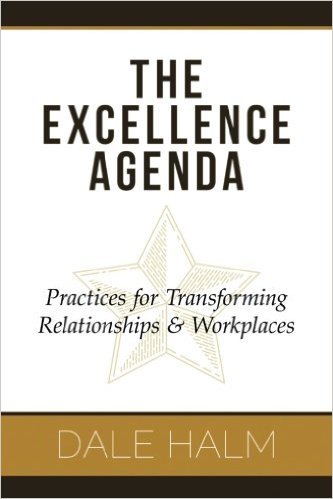Excellence Agenda
Practices for Transforming Relationships & Workplaces
Are you creating excellence in your relationships, in your workplace? This book will forever change how you approach working with others. In The Excellence Agenda, Dale Halm author and renowned business consultant, explores what it takes to truly excel. It reveals the mindset and behaviors needed for optimal performance. By offering a series of thought-provoking questions, this book provides a powerful roadmap for success. It includes:
- The Success Paradigm – alternative ways of thinking that foster collaboration
- Breakthrough Practices – crucial behaviors that lead to exceptional results
- Tools – guidelines for mastering the skills of excellence
- Excellence Survey – 20 questions to help you assess your ability to excel
The Excellence Agenda will inspire you to transform your relationships and workplace.
Featured Posts
September 15, 2021 | Dale Halm
Succeeding at Employee Engagement
Jack Welch, former CEO of GE said, "There are only three measurements that tell you nearly everything you need to know about your organization's overall performance: employee engagement, customer satisfaction, and cash flow." Clearly, in today's cusiness world, employee engagement is seen as a critical success factor. Management consulting firm Hewitt Associates reported recently that organizations with high levels of engagement outperformed the total stock market index. Total shareholder return for these companies was 19% higher than the average total shareholder return.
Many companies have outstanding employee engagement programs, yet there is also a LOT of confusion about what it is and how to make it a reality. I know because I worked in two large companies helping to drive employee engagement where all my hard effort resulted in wheel spinning versus launching a successful program. Here are three things I learned that can help make or break employee engagement.
1. Think End Result
What do you want to achieve? Many organizations focus heavily on formulating and implementing surveys which provides detailed analytics allowing leaders to thoroughly diagnose their culture. Robust action planning is often part of the process as well. This, however, does not equal employee engagement. It only sets the stage for potential action. You need to be asking three questions:
- Ultimately what do we want to achieve regarding employee engagement?
- Is an employee engagement survey really needed?
- If you know what you want (end result) what’s stopping you from taking action now?
2. Define Terms
Employee engagement is a term that gets discussed often, yet many people are unclear on what it means. I define employee engagement as the extent to which employees commit to something or someone in their organization. It’s more than how employees feel; it's what they do that matters most. Think of it this way. Satisfaction is a measure of how much I like it here. Commitment determines how much I want to be here. Engagement reveals how much I behave in ways that improve business results and further the organization's agenda. Highly engaged employees are willing to invest discretionary effort and feel a strong emotional bond to the organization.
3. Provide Leadership
It’s common knowledge that most people leave jobs because of poor leadership. When you examine key drivers of employee engagement and study the complexity of systems that can enhance it – it’s easy to see why efforts to involve the workforce fail to produce desired results. There are simply too many things to try and influence; reward systems, company reputation, career development, employee well-being, etc. My suggestion is to substitute leadership. When you select good managers, develop and coach them, and hold them accountable for modeling effective behaviors amazing things happens. People are engaged, leverage their potential, and contribute their talents to improving the bottom line. Perhaps engagement surveys should be leadership surveys asking:
- How do we tap the full potential of our workforce to meet our business challenges?
- What actions are we demonstrating that increase or decrease engagement?
- What do we need to do differently to ensure high levels of employee engagement?
Does your organization need a full blown employee engagement program? It might, or perhaps you need to focus on other things. Organizations must go beyond surveys. If you want a high-performance culture your leaders need to know what employee engagement really means and the impact it has on productivity. Leaders need to unleash the potential of their workforce. When people’s skills are maximized, when they feel valued and know they are contributing to the bottom line, engagement skyrockets.

